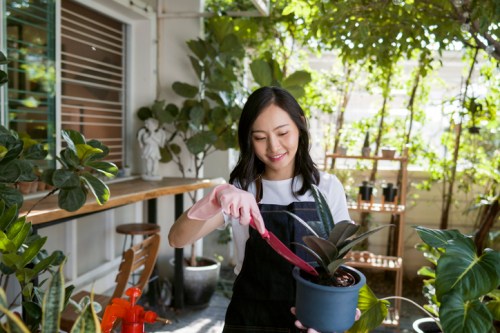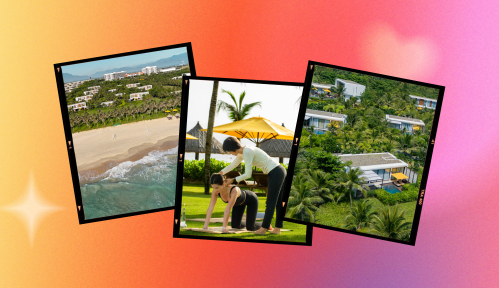5 Common Mistakes When Moving Indoor Plants Outside, According to a Plant Doctor
A plant doctor explains how to move your indoor plants outside for the summer—and the biggest mistakes to avoid.

The warmer seasons are the time to get outdoors and enjoy everything you’ve been missing while the world froze over. Your flowers, ferns, and figs feel the very same way. Since we’ve domesticated our plants, it’s easy to forget that they once, too, thrived in the great outdoors. So, if you’re thinking of moving your indoor plants outside for the warmer months, here’s a plant doctor’s step-by-step guide for doing it correctly.
Experts in This Article
horticulture consultant and professor of plant biology and pathology at the New York Botanical Garden
Although moving your plants outside sounds easy in theory (you just pick up the pots and put them on your porch, right?), the process is a little more complicated than that. Outdoor conditions are tricky for your plants to adapt to at first, so you’ll need to choose an ideal spot in your garden and coddle them for a couple weeks after their relocation. Below, Chris Satch, plant doctor with Horti, walks you through sending your plants on a summer vacay (to the backyard).
Which indoor plants you should move outside and when
All your plants can take a trip outside, but there is a caveat: You need to survey your garden and make sure the conditions are right. If you don’t have any shade, for example, you plants will probably live their best lives inside. “For all plants, ensure that they are moved into full shade for two weeks when first brought outdoors,” says Satch.
If your yard gets hours and hours of sunshine, consider moving them to a covered porch or simply keeping them indoors. Remember: we ultimately want your plants to live to see next spring, so don’t put them outside if there’s no ideal spot for them.
As for when you should move your indoor garden outdoors, Satch says that looking at the daily high and low temperatures in your area is key. “The first step to bringing plants outdoors is to monitor the temperature daily, paying attention to not just the highs, but also the lows of the day. It’s best to bring plants out when the night time low temperature is consistently about 55°F,” he explains. Otherwise, they could freeze and die—which wouldn’t been a great way to kickoff springtime, right?
How to move your indoor plants outside and pick the right location
Once the temperature is nestled in that above-55 sweet spot, you’re ready to migrate your plants outside. As Satch mentioned, you’ll want to keep your plants in full shade while they get accustomed to their new digs. “To acclimate your plants to outdoor light levels, put them in full shade outdoors for two weeks, then slowly move them to brighter areas, depending on how much light they need,” says Satch.
Succulents and cacti are sturdy desert plants. And thus, after leaving them in the shade for two weeks, you can move them to part-sun conditions for a day or two before placing them in their final summer spot in direct sunlight. “Low-light” plants and other tropical plants can stay in the shade or move to a spot where they’re only receive an hour or two of sunlight per day.
Now, you may be thinking: How will my plants grow if they don’t have any sun? Good question: “The solar energy is so powerful [outdoors] that your plants may double or triple in size after only one season outside,” says Satch. So even if your plants aren’t exactly sunbathing, they’re still soaking up the vitamin D they need to make gains as the warmer months go by.
Satch also recommends giving them a little fertilizer love once you’ve made the move.
The most common mistakes people make when moving indoor plants outside
1. Taking your plants outside too early in the season
As Satch has already warned, toting your plants outdoors too early in spring could lead to their early demise. Be patient and wait for weather upwards of 55°F, okay?
2. Choosing a spot that’s too windy
“Indoor plants haven’t been hardened enough to handle windy conditions, so you will need to put them in a location where they will not be battered by the wind, like near the house or close to some other wind-blocking obstacle,” Satch explains. If one day is going to be extra, extra windy, consider moving them inside until the air stills again.
3. Not checking for pests
House plant bugs are a huge nuisance to your plants, but outdoor pests should also be a cause for caution, according to Satch. “Insects will always be a problem when you put your plants outdoors, so let go of the perfectionist mindset that the leaves will always stay flawless,” he says. “Pests are expected, but an infestation is not. Usually, the beneficial insects in your yard ought to keep the pests in check, but occasionally, you will need to treat any largely infested plant with an insecticide of your choice.”
Despite potential infestations, relocating your plants outdoors is still worthwhile, says Satch. Remember that your plants will grow way faster and get to enjoy a new habitat for a while. (Plus, they’ll make your garden parties and backyard barbecues with friendsso much prettier.)
4. Under-watering your plants
While your plants are calling the great outdoors their home, they will need a lot more water. The good news? You can depend on spring and summer showers to help you out. The not-so-great news? You’ll have to make sure to get out there with your watering can if it’s a hot, cloudless day. Make sure to check on your plants every other day to see how they’re doing, and read up on how often your specific plant varieties require some H2O.
5. Failing to monitor the temperatures in summer
Summer heatwaves are another threat to the health and well-being of your outdoor garden—so be on the lookout for unideal conditions. “You don’t have to pay attention to the highs until summertime, when it starts to get above 95°F,” says Satch. “During a heatwave, you will need to water [your plants] daily to help offset the heat getting water on the leaves will help cool them if applied in the early morning.” (Make sure you’re keeping yourself extra hydrated during the heatwave, too.)
When is it time to move your plants back inside?
Ah, so summer has come to an end and you’re wondering if it’s time to reintroduce your plants to the indoors? “It’s best to bring plants back in when the night time low temperature drops under 55°F,” says Satch. Hey, at least you’ll get to cozy up and enjoy the great indoors with them in the cooler months.









